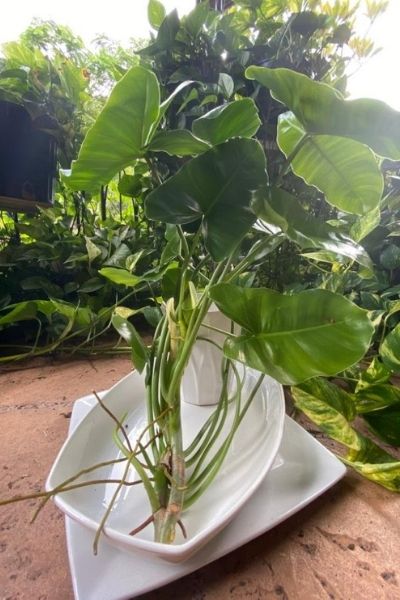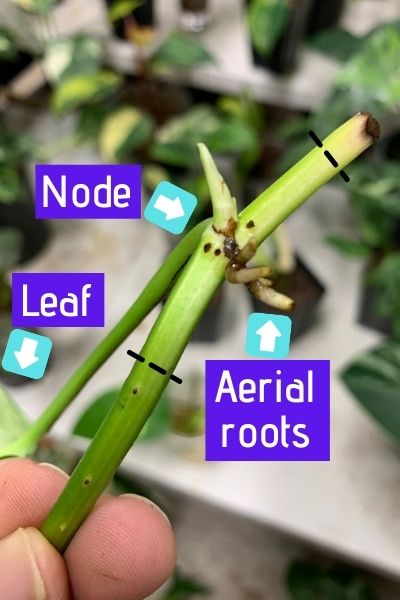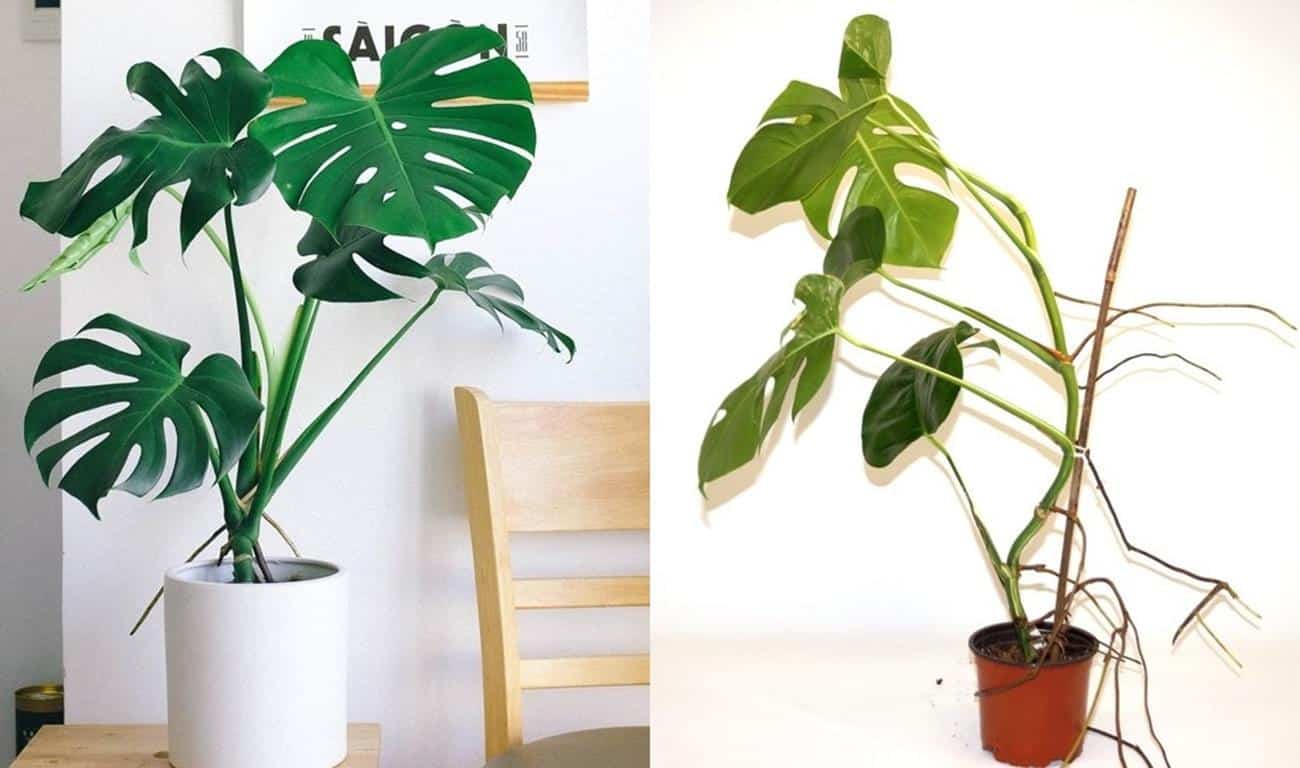Are your Philodendron cuttings not rooting and you don't know why? Even though they say that propagating a Philodendron is very easy, it can still sometimes go wrong.
In this article, I will go over the top 11 possible reasons why your Philodendron cuttings are not rooting. Even if your cuttings are wilting, turning brown or black, this article got you covered!

Features image by TropicalplantsFL from Etsy.
Contents
- Why you Philodendron cuttings are not rooting
- 1. You are propagating at the wrong time of the year
- 2. You are propagating an unhealthy, weak, or too young plant
- 3. Your cuttings are the wrong size
- 4. The cuttings are not receiving enough light
- 5. You didn't include a node
- 6. You tried to callus the cutting
- 7. You are keeping the cuttings in the wrong temperatures
- 8. You are using water that is not fresh
- 9. Using the wrong soil to grow cuttings in
- 10. You are not patient enough
- 11. You are growing the cuttings in low humidity
- Conclusion
Why you Philodendron cuttings are not rooting
1. You are propagating at the wrong time of the year
The best time of the year to take propagate a Philodendron is at the beginning of the growing season (in spring and early summer). Planting the cutting during this time will make sure it quickly develops strong roots to survive the winter.
Trying to propagate during fall and winter will drastically decrease the rate of success that your cuttings are going to root. It may take up to spring for the cutting to start rooting, while in the meantime, the cutting will most likely rot.
Diving even deeper in the time of propagation, the best time of the day to take your cuttings is in the early morning. Because during this time, the parent plant is still full of water which guarantees the best chance of rooting.
2. You are propagating an unhealthy, weak, or too young plant
Taking a cutting for propagation will cause stress on the plant. Besides, it will cost a lot of energy for a cutting to start rooting. If you try to propagate an unhealthy or weak plant, the cutting might not have enough energy to start rooting.
Also, you don't want to chop off newly grown stems because these stems are still in development and might not contain the right amount of energy to start rooting.
When it comes to choosing the right cutting, pick a mature and healthy stem and make sure the plant is not infected with a pest.
3. Your cuttings are the wrong size
The size of a cutting is an important factor involving the rooting ability and growth performance. If the cutting is too long, it might not be able to generate the right amount of energy (with the help of sunlight) to grow roots. Too much energy is wasted on all the parts of the cutting and there will not be enough energy for the roots.
The perfect cutting would consist of one node and at least one leaf. Cut 0.5 to 1 inch (1 to 2.5 cm) above and below a node and make sure that there is at least one leaf attached to that node. Also, see the picture of a Philodendron Burle Marx at the top of this article.
4. The cuttings are not receiving enough light
No matter if you want to root your Philodendron cuttings in water or directly in the soil, the right amount of light is always important. The cuttings need light to create enough energy to start rooting and growing.
The Philodendron cuttings grow best in bright indirect sunlight.
If the cuttings do not receive enough sunlight, they won't be able to generate enough energy to root.
- On the other hand, you want to keep the cuttings away from direct sunlight because this will burn the leaves and stop the root growth.
5. You didn't include a node

Image by HoustonTropicalPlnts from Etsy.
For a Philodendron cutting to grow roots, it needs to have at least one node. Without a node (and aerial roots) a cutting is not able to root.
When taking a cutting, cut the stem 1 inch (2.5 cm) below the node and 1 inch above the node (black lines in the picture above).
It can also help the cutting root faster if you put some rooting-hormone on the ends of the cutting, but this is not necessary.
6. You tried to callus the cutting
Many people actually claim that they only have success with cuttings if they let them lie around for a few hours, or perhaps overnight, until a callus (layer of harder protective tissue) forms. However, this is a technique that only applies to succulents and doesn't need to be performed with Philodendrons.
Letting Philodendron cuttings callus overnight will actually decrease the chance of rooting.
If you have taken Philodendron cuttings, you don't want to wait too long before planting them in soil or put them in the water right away.
7. You are keeping the cuttings in the wrong temperatures
When it comes to temperatures, the Philodendron species like higher temperatures. Growing your cuttings in cold temperatures will slow down or even stop root growth. The ideal temperatures for the cuttings are:
- Day temperatures of at least 75°F (21°C)
- Night temperatures of at least 65°F (18°C)
On the other hand, growing your cuttings in temperatures that are too high will also slow down or even stop root growth. This is because the rate of photosynthesis will rapidly decline after a certain temperature has been reached.
The maximum temperature that these cuttings like is 85°F (29 °C).
8. You are using water that is not fresh
Some people claim that you don't necessarily have to change the water that the cuttings are in. However, Philodendrons are sensitive plants and don't like to sit in the same water for the entire propagation.
Fresh tap water retains oxygen which the cuttings use to survive and grow new roots. It's very important to refresh the water (that the cuttings are in) every 2-3 days to resupply the oxygen and prevent the cutting from rotting.
Refresh the water with regular room temperature tap water and your cutting should continue growing its roots.
Also, you don't want to put fertilizer in the water at this stage. Regular tap water contains enough minerals for the plant to grow new roots.
9. Using the wrong soil to grow cuttings in
This only applies when you are growing the cuttings directly in the soil. Philodendron cuttings need a well-draining soil mix. Using a soil mix that retains too much water can cause the cuttings to rot and stop the growth of the roots.
Philodendrons like a rich soil mix that also drains well in order to prevent root rot.
A good and well-draining soil that you could use for your Philodendron cuttings contains 1 part peat-based potting soil and 1 part coco coir (which is also called coco-fiber). You could also mix in some perlite.
When planting the cuttings directly in the soil, gently push the medium around the cuttings. Don't press the soil in too harshly, because this will reduce the drainage of the soil and cause problems.
10. You are not patient enough
Even if all the odds are in your favour and you are doing everything well, the Philodendron cuttings still need up to 6 weeks to fully develop new roots.
After 4 weeks of propagation, you want to check for any root growth. If you are growing the cuttings in water, you can take the cuttings out of the water and look if the roots are big enough. However, if you are growing the cuttings in soil, gently pull the cutting towards you. If you feel any resistance, that means the cutting has started to root.
Having enough patience is important when growing plants. Enjoy the time and watch how your Philodendron slowly grows its new roots!
11. You are growing the cuttings in low humidity
Philodendrons are tropical plants that naturally grow in high humidity environments. A lot of Philodendrons will grow just fine in normal humidity levels (around 40%). However, they grow best in humidity ranges of about 60-70%.
If you live in an environment where the air is really dry (below 30%), the Philodendron cuttings will have a hard time growing new roots.
You can increase the humidity around the plant by:
- Covering the propagation tray with plastic (poke a couple of holes in the plastic and spray plant with water)
- Placing the plant in a greenhouse
- Using a humidifier
- Misting the cuttings
Conclusion
Many factors will make a successful propagation happen. Keeping these factors in mind can make your cuttings root quicker!
I hope this top 11 list helped you and your Philodendron cuttings to root! If you learned something from this list, share it on social media which would help my blog out a lot!
If you liked this kind of content, also check out Care and Grow Guide for Alocasia maharani (Grey Dragon)




Leave a Reply